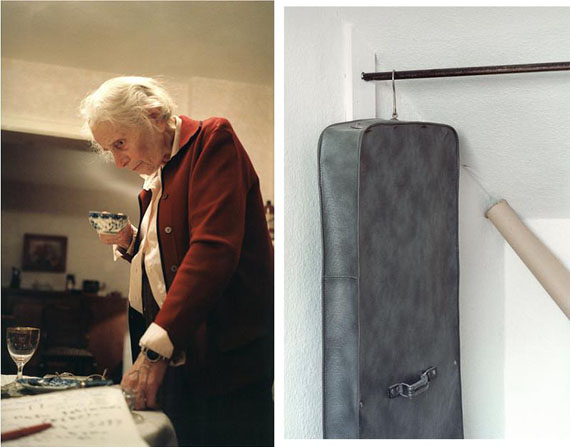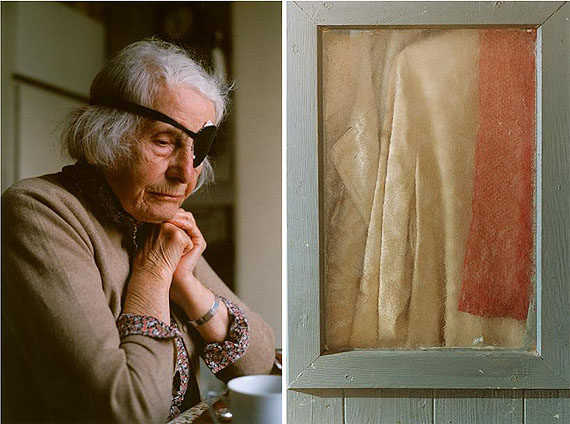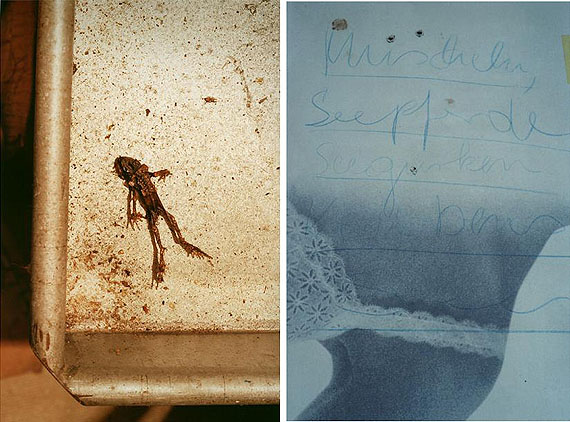
Ein Leben (One Life), 1997 - 2012, C-Prints,
Courtesy Jutta Kabuth Galerie, Gelsenkirchen und zone B, Berlin
Knut Wolfgang Maron »
Ein Leben (One Life)
Exhibition: 2 Sep – 4 Nov 2012
Sun 2 Sep 11:00

Kunsthalle Erfurt
Fischmarkt 7
99084 Erfurt
+49 (0)361-6555666
kunsthalle@erfurt.de
kunstmuseen.erfurt.de/kunsthalle
Tue-Sun 11-18, Thu 11-22

Ein Leben (One Life), 1997 - 2012, C-Prints,
Courtesy Jutta Kabuth Galerie, Gelsenkirchen und zone B, Berlin
THE ESTATE- RECORD OF A LIFE
My mother died at the age of 82. Shortly before her death she still was able to ride her bicycle to take care of her home and do the shopping on her own.
All of a sudden she felt sharp pain in her bones. The first diagnosis of leukemia was not pursued by her family physician or by others. She was sent from one hospital to another. The experts did not explore the possibility of leukemia and decided that she had osteoporosis. This was the wrong diagnosis. They did not give her the only treatment that could have saved her. She had a curable leukemia, but it was treated too late. She lost 12 kilograms and shrank to one meter 40 centimeters. She had to suffer.
Every minute that I was available, I spent with my mother. I cooked for her. I organized the household and started to take pictures of her and the objects surrounding her. My mother wanted to discuss everything connected with her death. She discussed the contents of the house, so that the objects would find a new place, a new home, and not be cast anyway. Who would need which furniture? What to do with the never used table cloth? What to do with the 40, 50, 60, year old brooms? I refused the dishes- we were still eating from them. I refused the sofa- we were still stilling on it. Goods and chattel collected over my mother’s whole life were a distribution- and dumping problem..
CONCEPT
Through photography I started to preserve the objects in their original context. I could condense the syntax of a private and domestic life, and identify the culture of an over 80-year-old woman and the environment she created. This work began under the strain of mourning and sorrow, private memories, subjective feelings. It nevertheless presents a point of view that is sociologically and philosophically considered and contemplative. This perspective refers to the unity and the sense of the objects.
My mother was treated carelessly by her doctors; she herself treated all with care. Everything in the house has its order, its destiny, and its place. If an object does not have a use, habit, or custom, it has a sacred character as in a place of worship. Respect toward the objects is obviously visible in the pictures already done. The cleaning rag (see picture) was used so long it atomized, fell into pieces. Daily custom and habit form the basis of the photographic reality.
The photographs form an important portrait of the generation of which my mother was a member, the generation that grew up and was socialized between the two world wars, and that experienced the defeat in WWI, wild inflation, poverty, starvation, Fascism, defeat in WW II, the division and reconstruction of Germany, the Cold War, and Reunification. I am recording this world before it is destroyed, divided, torn into pieces. The photographs are a testament to the daily culture of a whole generation, one that cherished and husbanded belongings and never adopted the more materialist, "disposable” culture of the generation that followed. The work will represent a whole life, that of my mother, and through her many others. The Estate: Record of a Life will be a social critique of the throw-away society in which even people are treated as disposable objects.
Maron studied at the Folkwangschule in Essen in the class of Prof. Dr. Otto Steinert and Prof. Erich vom Endt along with Gosbert Adler, Joachim Brohm and Andreas Gursky, and Volker Heinze.
Fundamental discourses among the Folkwang students took place in the colour photography lab at the first professional colour photography department in a German university set up by Erich vom Endt.
Ute Eskildsen initially exhibited Maron's first colour photographs from 1979 at the Museum Folkwang in 1981. Knut Maron has received numerous scholarships and prizes, among them the Leopold Godowsky Jr. Award for Color Photography awarded to him by the Photographic Resource Center at Boston University in 1993. Knut Maron's works are represented in many collections, such as Museum Folkwang, Essen; Museum Ludwig, Cologne; Staatsgalerie Stuttgart; Musée Européen de la Photo, Paris; Bibliothèque Nationale de France, Paris.
Knut Wolfgang Maron
Exhibition
„Knut Wolfgang Maron. Ein Leben (One Life)“,
2 September to 4 November 2012 | Kunsthalle Erfurt,
18 November 2012 to 13 January 2013 | Kunstmuseum Mülheim/Ruhr,
22 February to 16 May 2013 | Staatliches Museum Schwerin,
19. October to 29 November 2013 | White Box, New York
Knut Wolfgang Maron
Ein Leben
Fotografie
2. September - 4. November 2012
Eröffnung: Sonntag, 2. September, 11 Uhr
Was bleibt, wenn ein Mensch die Welt der Lebenden verlässt? Individuelle Erinnerungen, Bilder von der Erscheinung dieses Menschen, vielleicht ein Erbe oder ein paar Habseligkeiten als Gabe an die Nachkommenden. Obwohl das Sterben zum Leben gehört wie das Geborenwerden, neigt die moderne, funktional ausdifferenzierte Gesellschaft zur Verdrängung des Bewusstseins von der Sterblichkeit und der Anwesenheit Sterbender, weist ihnen spezielle Bereiche zu, die der alltäglichen Erfahrung nicht mehr zugänglich sind. Gern überlässt man das Feld den Spezialisten – Altenpflegern, Ärzten, Psychologen und Geistlichen. Anders der Essener Fotograf Knut Wolfgang Maron (*1954). Er führte im Haus seiner 82jährigen Mutter fotografisch Tagebuch über die letzte Phase ihres Lebens; teilte mit ihr „eine wunderbare und nicht benennbare Intimität“, wie er es selbst formuliert. Es entstanden berührende Bilder nicht nur von der Mutter in ihrer rapide zunehmenden körperlichen Zerbrechlichkeit, sondern auch von der sichtbaren Ordnung, die ihr Leben prägte. Ein halbe Ewigkeit bewohnte die Mutter ein Haus, schuf in diesem Raum ein Bezugssystem, das ihren Alltag strukturierte und nun – in der Perspektive des Fotografen – symbolisch auch die innere Ordnung dieser Persönlichkeit zum Ausdruck bringt. Das Leben im Gleichmaß alltäglicher Verrichtungen, unterstützt von Gegenständen, denen der lange und intensive Gebrauch in die Oberflächen eingeschrieben wurde. Hinter all diesen Dingen scheint indirekt das Bild der Mutter auf, wird aber auch die Nähe spürbar, die der Sohn sucht und die Trauer des Abschiednehmens. Nichts Spektakuläres erscheint da im Bild, doch in der Intensität der fotografischen Einfühlung in ein anderes Leben, das sich sichtbar seinem Ende zuneigt, ein künstlerisches Ereignis, das zu Recht mehrfach mit Preisen gewürdigt wurde und nun in der Auswahl einer Ausstellung auf Reisen geht. Die Kunsthalle Erfurt kooperiert für diese Ausstellung mit dem Kunstmuseum Mülheim an der Ruhr und dem Staatlichen Museum Schwerin.
Anlässlich der Ausstellung erscheint ein Katalog im Kerber Verlag, herausgegeben von Dirk Blübaum und Gerhard Graulich, mit Beiträgen von Gerhard Graulich, Laurent Jouannaud und Andreas Steffens, ca. 160 Seiten, Hardcover, gebunden, ISBN: 978-3-86678-737-7, Preis 30 Euro(D)

Ein Leben (One Life), 1997 - 2012, C-Prints,
Courtesy Jutta Kabuth Galerie, Gelsenkirchen und zone B, Berlin

Ein Leben (One Life), 1997 - 2012, C-Prints,
Courtesy Jutta Kabuth Galerie, Gelsenkirchen und zone B, Berlin